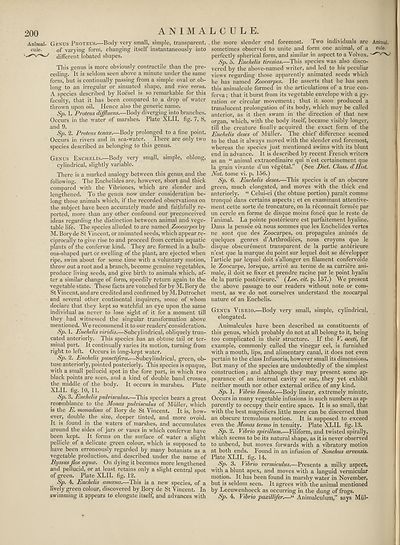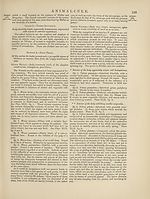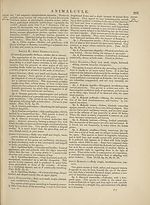Encyclopaedia Britannica > Volume 3, Anatomy-Astronomy
(208) Page 200
Download files
Complete book:
Individual page:
Thumbnail gallery: Grid view | List view

200 A N I M A
Animal- Genus Proteus.—Body very small, simple, transparent,
cule. of varying form, changing itself instantaneously into
different lobated shapes.
This genus is more obviously contractile than the pre¬
ceding. It is seldom seen above a minute under the same
form, but is continually passing from a simple oval or ob¬
long to an irregular or sinuated shape, and vice versa.
A species described by Roesel is so remarkable for this
faculty, that it has been compared to a drop of water
thrown upon oil. Hence also the generic name.
Sp. 1. Proteus diffluens.—Body diverging into branches.
Occurs in the water of marshes. Plate XLII. fig. 7, 8,
and 9.
Sp. 2. Proteus tenax.—Body prolonged to a fine point.
Occurs in rivers and in sea-water. There are only two
species described as belonging to this genus.
Genus Enchelis.—Body very small, simple, oblong,
cylindrical, slightly variable.
There is a marked analogy between this genus, and the
following. The Enchelides are, however, short and thick
compared with the Vibriones, which are slender and
lengthened. To the genus now under consideration be¬
long those animals which, if the recorded observations on
the subject have been accurately made and faithfully re¬
ported, more than any other confound our preconceived
ideas regarding the distinction between animal and vege¬
table life. The species alluded to are named Zoocarpes by
M. Boiy de St Vincent, or animated seeds, which appear re¬
ciprocally to give rise to and proceed from certain aquatic
plants of the conferva? kind. They are formed in a bulb¬
ous-shaped part or swelling of the plant, are ejected when
ripe, swim about for some time with a voluntary motion,
throw out a root and a branch, become genuine vegetables,
produce living seeds, and give birth to animals which, af¬
ter a similar change of form, speedily return again to the
vegetable state. These facts are vouched for by M. Bory de
St Vincent, andare credited and confirmed by M.Dutrochet
and several other continental inquirers, some of whom
declare that they kept so watchful an eye upon the same
individual as never to lose sight of it for a moment till
they had witnessed the singular transformation above
mentioned. We recommend it to our readers’ consideration.
Sp. 1. Enchelis viridis.—Subcylindrical, obliquely trun¬
cated anteriorly. This species has an obtuse tail or ter¬
minal part. It continually varies its motion, turning from
right to left. Occurs in long-kept water.
Sp. 2. Enchelis punctifera.-—Subcylindrical, green, ob¬
tuse anteriorly, pointed posteriorly. This species is opaque,
with a small pellucid spot in the fore part, in which two
black points are seen, and a kind of double band crosses
the middle of the body. It occurs in marshes. Plate
XLII. fig. 10, 11.
Sp. 3. Enchelis pidviscidus.—This species bears a great
resemblance to the Monas pidviscidus of Muller, which
is the E. monadina of Bory de St Vincent. It is, how¬
ever, double the size, deeper tinted, and more ovoid.
It is found in the waters of marshes, and accumulates
around the sides of jars or vases in which conferva? have
been kept. It forms on the surface of water a slight
pellicle of a delicate green colour, which is supposed to
have been erroneously regarded by many botanists as a
vegetable production, and described under the name of
Byssus flos aquae. On dying it becomes more lengthened
and pellucid, or at least retains only a slight central spot
of green. Plate XLII. fig. 12.
Sp. 4, Enchelis amcena.—This is a new species, of a
lively green colour, discovered by Bory de St Vincent. In
swimming it appears to elongate itself, and advances with
L C U L E.
. the more slender end foremost. Two individuals are Animal,
sometimes observed to unite and form one animal, of a cule.
perfectly spherical form, and similar in aspect to a Volvox.
Sp. 5. Enchelis tiresias.—This species was also disco¬
vered by the above-named writer, and led to his peculiar
views regarding those apparently animated seeds which
he has named Zoocarpes. He asserts that he has seen
this animalcule formed in the articulations of a true con¬
ferva ; that it burst from its vegetable envelope with a gy¬
ration or circular movement; that it soon produced a
translucent prolongation of its body, which may be called
anterior, as it then swam in the direction of that new
organ, which, with the body itself, became visibly longer,
till the creature finally acquired the exact form of the
Enchelis deses of Muller. The chief difference seemed
to be that it always moved with the slender end foremost,
whereas the species just mentioned swims with its blunt
end in advance. It is described by recent French writers
as an “ animal extraordinaire qui n’est certainement que
la grain vivante d’un vegetal.” (See Diet. Class, d'Hist.
Nat. tome vi. p. 156.)
Sp. 6. Enchelis deses.—This species is of an obscure
green, much elongated, and moves with the thick end
anteriorly. “ Celui-ci (the obtuse portion) parait comme
tronque dans certains aspects; et en examinant attentive-
men t cette sorte de troncature, on la reconnait formee par
un cercle en forme de disque moins fence que le reste de
I’animal. La pointe posterieure est parfaitement hyaline.
Dans la pensee ou nous sommes que les Enchelides vertes
ne sont que des Zoocarpes, ou propagules animes de
quelques genres d’Arthrodiees, nous croyons que le
disque obscurement transparent de la partie anterieure
n’est que la marque du point sur lequel doit se developper
1’article par lequel doit s’allonger en filament confervoide
le Zoocarpe, lorsque, arrive au terme de sa carriere ani-
male, il doit se fixer et prendre racine par le point hyalin
de la partie posterieure.” (Zoc. cit. p. 157.) We present
the above passage to our readers without note or com¬
ment, as we do not ourselves understand the zoocarpal
nature of an Enchelis.
Genus Vibrio.—Body very small, simple, cylindrical,
elongated.
Animalcules have been described as constituents of
this genus, which probably do not at all belong to it, being
too complicated in their structure. If the V. aceti, for
example, commonly called the vinegar eel, is furnished
with a mouth, lips, and alimentary canal, it does not even
pertain to the class Infusoria, however small its dimensions.
But many of the species are undoubtedly of the simplest
construction; and although they may present some ap¬
pearance of an internal cavity or sac, they yet exhibit
neither mouth nor other external orifice of any kind.
Sp. 1. Vibrio lineola.—Body linear, extremely minute.
Occurs in many vegetable infusions in such numbers as ap¬
parently to occupy their entire space. It is so small, that
with the best magnifiers little more can be discerned than
an obscure tremulous motion. It is supposed to exceed
even the Monas termo in tenuity. Plate XLII. fig- 13.
Sp. 2. Vibrio spirillum.—Filiform, and twisted spirally,
which seems to be its natural shape, as it is never observed
to unbend, but moves forwards with a vibratory motion
at both ends. Found in an infusion of Sonchus arvensis.
Plate XLII. fig. 14.
Sp. 3. Vibrio vermiculus.—Presents a milky aspect,
with a blunt apex, and moves with a languid vermicular
motion. It has been found in marshy water in November,
but is seldom seen. It agrees with the animal mentioned
by Leeuwenhoeck as occurring in the dung of frogs.
Sp. 4, Vibrio paxillifer.—“ Animalculum,” says Mfil-
Animal- Genus Proteus.—Body very small, simple, transparent,
cule. of varying form, changing itself instantaneously into
different lobated shapes.
This genus is more obviously contractile than the pre¬
ceding. It is seldom seen above a minute under the same
form, but is continually passing from a simple oval or ob¬
long to an irregular or sinuated shape, and vice versa.
A species described by Roesel is so remarkable for this
faculty, that it has been compared to a drop of water
thrown upon oil. Hence also the generic name.
Sp. 1. Proteus diffluens.—Body diverging into branches.
Occurs in the water of marshes. Plate XLII. fig. 7, 8,
and 9.
Sp. 2. Proteus tenax.—Body prolonged to a fine point.
Occurs in rivers and in sea-water. There are only two
species described as belonging to this genus.
Genus Enchelis.—Body very small, simple, oblong,
cylindrical, slightly variable.
There is a marked analogy between this genus, and the
following. The Enchelides are, however, short and thick
compared with the Vibriones, which are slender and
lengthened. To the genus now under consideration be¬
long those animals which, if the recorded observations on
the subject have been accurately made and faithfully re¬
ported, more than any other confound our preconceived
ideas regarding the distinction between animal and vege¬
table life. The species alluded to are named Zoocarpes by
M. Boiy de St Vincent, or animated seeds, which appear re¬
ciprocally to give rise to and proceed from certain aquatic
plants of the conferva? kind. They are formed in a bulb¬
ous-shaped part or swelling of the plant, are ejected when
ripe, swim about for some time with a voluntary motion,
throw out a root and a branch, become genuine vegetables,
produce living seeds, and give birth to animals which, af¬
ter a similar change of form, speedily return again to the
vegetable state. These facts are vouched for by M. Bory de
St Vincent, andare credited and confirmed by M.Dutrochet
and several other continental inquirers, some of whom
declare that they kept so watchful an eye upon the same
individual as never to lose sight of it for a moment till
they had witnessed the singular transformation above
mentioned. We recommend it to our readers’ consideration.
Sp. 1. Enchelis viridis.—Subcylindrical, obliquely trun¬
cated anteriorly. This species has an obtuse tail or ter¬
minal part. It continually varies its motion, turning from
right to left. Occurs in long-kept water.
Sp. 2. Enchelis punctifera.-—Subcylindrical, green, ob¬
tuse anteriorly, pointed posteriorly. This species is opaque,
with a small pellucid spot in the fore part, in which two
black points are seen, and a kind of double band crosses
the middle of the body. It occurs in marshes. Plate
XLII. fig. 10, 11.
Sp. 3. Enchelis pidviscidus.—This species bears a great
resemblance to the Monas pidviscidus of Muller, which
is the E. monadina of Bory de St Vincent. It is, how¬
ever, double the size, deeper tinted, and more ovoid.
It is found in the waters of marshes, and accumulates
around the sides of jars or vases in which conferva? have
been kept. It forms on the surface of water a slight
pellicle of a delicate green colour, which is supposed to
have been erroneously regarded by many botanists as a
vegetable production, and described under the name of
Byssus flos aquae. On dying it becomes more lengthened
and pellucid, or at least retains only a slight central spot
of green. Plate XLII. fig. 12.
Sp. 4, Enchelis amcena.—This is a new species, of a
lively green colour, discovered by Bory de St Vincent. In
swimming it appears to elongate itself, and advances with
L C U L E.
. the more slender end foremost. Two individuals are Animal,
sometimes observed to unite and form one animal, of a cule.
perfectly spherical form, and similar in aspect to a Volvox.
Sp. 5. Enchelis tiresias.—This species was also disco¬
vered by the above-named writer, and led to his peculiar
views regarding those apparently animated seeds which
he has named Zoocarpes. He asserts that he has seen
this animalcule formed in the articulations of a true con¬
ferva ; that it burst from its vegetable envelope with a gy¬
ration or circular movement; that it soon produced a
translucent prolongation of its body, which may be called
anterior, as it then swam in the direction of that new
organ, which, with the body itself, became visibly longer,
till the creature finally acquired the exact form of the
Enchelis deses of Muller. The chief difference seemed
to be that it always moved with the slender end foremost,
whereas the species just mentioned swims with its blunt
end in advance. It is described by recent French writers
as an “ animal extraordinaire qui n’est certainement que
la grain vivante d’un vegetal.” (See Diet. Class, d'Hist.
Nat. tome vi. p. 156.)
Sp. 6. Enchelis deses.—This species is of an obscure
green, much elongated, and moves with the thick end
anteriorly. “ Celui-ci (the obtuse portion) parait comme
tronque dans certains aspects; et en examinant attentive-
men t cette sorte de troncature, on la reconnait formee par
un cercle en forme de disque moins fence que le reste de
I’animal. La pointe posterieure est parfaitement hyaline.
Dans la pensee ou nous sommes que les Enchelides vertes
ne sont que des Zoocarpes, ou propagules animes de
quelques genres d’Arthrodiees, nous croyons que le
disque obscurement transparent de la partie anterieure
n’est que la marque du point sur lequel doit se developper
1’article par lequel doit s’allonger en filament confervoide
le Zoocarpe, lorsque, arrive au terme de sa carriere ani-
male, il doit se fixer et prendre racine par le point hyalin
de la partie posterieure.” (Zoc. cit. p. 157.) We present
the above passage to our readers without note or com¬
ment, as we do not ourselves understand the zoocarpal
nature of an Enchelis.
Genus Vibrio.—Body very small, simple, cylindrical,
elongated.
Animalcules have been described as constituents of
this genus, which probably do not at all belong to it, being
too complicated in their structure. If the V. aceti, for
example, commonly called the vinegar eel, is furnished
with a mouth, lips, and alimentary canal, it does not even
pertain to the class Infusoria, however small its dimensions.
But many of the species are undoubtedly of the simplest
construction; and although they may present some ap¬
pearance of an internal cavity or sac, they yet exhibit
neither mouth nor other external orifice of any kind.
Sp. 1. Vibrio lineola.—Body linear, extremely minute.
Occurs in many vegetable infusions in such numbers as ap¬
parently to occupy their entire space. It is so small, that
with the best magnifiers little more can be discerned than
an obscure tremulous motion. It is supposed to exceed
even the Monas termo in tenuity. Plate XLII. fig- 13.
Sp. 2. Vibrio spirillum.—Filiform, and twisted spirally,
which seems to be its natural shape, as it is never observed
to unbend, but moves forwards with a vibratory motion
at both ends. Found in an infusion of Sonchus arvensis.
Plate XLII. fig. 14.
Sp. 3. Vibrio vermiculus.—Presents a milky aspect,
with a blunt apex, and moves with a languid vermicular
motion. It has been found in marshy water in November,
but is seldom seen. It agrees with the animal mentioned
by Leeuwenhoeck as occurring in the dung of frogs.
Sp. 4, Vibrio paxillifer.—“ Animalculum,” says Mfil-
Set display mode to:
![]() Universal Viewer |
Universal Viewer | ![]() Mirador |
Large image | Transcription
Mirador |
Large image | Transcription
Images and transcriptions on this page, including medium image downloads, may be used under the Creative Commons Attribution 4.0 International Licence unless otherwise stated. ![]()
| Encyclopaedia Britannica > Encyclopaedia Britannica > Volume 3, Anatomy-Astronomy > (208) Page 200 |
|---|
| Permanent URL | https://digital.nls.uk/193760052 |
|---|
| Attribution and copyright: |
|
|---|---|
| Shelfmark | EB.16 |
|---|---|
| Description | Ten editions of 'Encyclopaedia Britannica', issued from 1768-1903, in 231 volumes. Originally issued in 100 weekly parts (3 volumes) between 1768 and 1771 by publishers: Colin Macfarquhar and Andrew Bell (Edinburgh); editor: William Smellie: engraver: Andrew Bell. Expanded editions in the 19th century featured more volumes and contributions from leading experts in their fields. Managed and published in Edinburgh up to the 9th edition (25 volumes, from 1875-1889); the 10th edition (1902-1903) re-issued the 9th edition, with 11 supplementary volumes. |
|---|---|
| Additional NLS resources: |
|

